Japanese Ingredient Highlight: Shio koji (塩麹, 塩糀). A century-old natural seasoning used in Japanese cooking to marinate, tenderize, and enhance umami flavor of a dish. Learn more about this all-purpose seasoning.
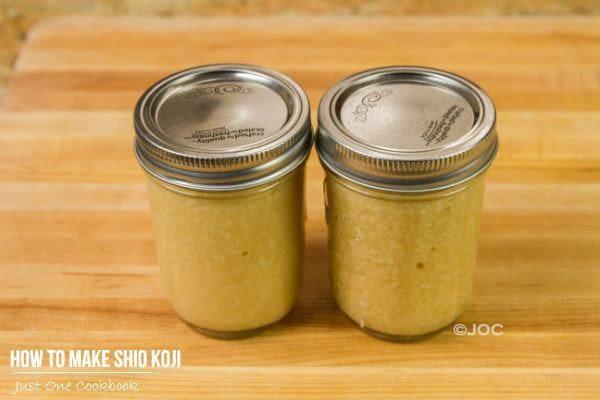
It’s been several years since Shio Koji (塩麹, 塩糀) experienced a huge resurgence in popularity as a versatile seasoning in Japan. This page is about shio koji, its benefits in cooking, and how to make it at home.
What is Shio Koji?
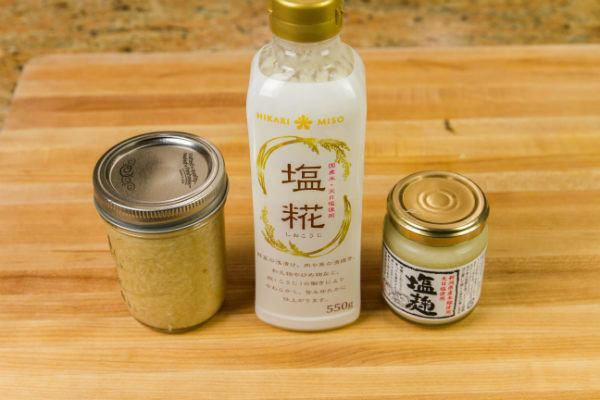
Shio koji (塩麹, 塩糀) is a natural seasoning used to marinate, tenderize, and enhance the umami, or richness (one of the five basic tastes) in foods. It’s made of just a few simple ingredients: salt, water, and rice koji.
Rice koji (米こうじ, 米糀, 米麹) is steamed rice that has been treated with koji mold spores (Aspergillus oryzae, koji-kin 麹菌, or koji starter). Koji is a specific strain of mold that has been cultured over the centuries.
You may feel hesitant to eat it and wonder why we make rice moldy on purpose. But you have most likely eaten it already!
Koji has been the key ingredient in making miso, soy sauce, sake, mirin, rice vinegar, amazake, shochu, and shio koji. It’s a live food that is rich in enzymes that break down starches and proteins in food into sugars and amino acids.
You can use shio koji to marinate meats, make pickles, flavor your vegetables or use it as a salt substitute. In a recipe that calls for one teaspoon of salt, you can substitute with 2 teaspoons of shio-koji. Shio-koji is really versatile and can be used in any kind of cooking (See Shio Koji recipes)!
Benefits of Shio Koji
Because it is a fermented ingredient, shio koji is known for its many health benefits, which include (source):
- A natural pro-biotic seasoning
- Tenderizes food
- Brings out the umami and sweetness in foods
- Reduces the intake of salt
- Aids for digestion
- Clear the skin
- Anti-aging
- Contains minerals, fiber, and vitamins
How to Make Shio Koji at Home
Yes, you can make shio koji at home as it only involves a few ingredients. You can check out my quick video that demonstrates the process. For a step-by-step recipe, read on in the recipe section below. I hope you have fun making Shio Koji at home and discover more ways to flavor your dishes with this amazing ingredient!
Recipes with Shio Koji
Where Can We Find Rice Koji?
Rice koji can be found in Japanese grocery stores or online. I found the following Japanese brand in a Japanese grocery store.
Resources
To read more about koji, please read here, here, here (Japanese), and here (Japanese).
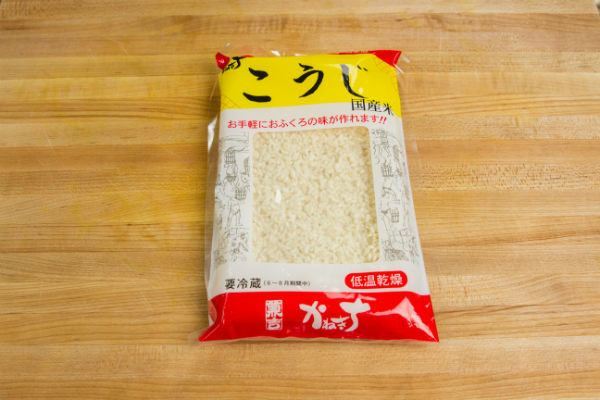
Wish to learn more about Japanese cooking? Sign up for our free newsletter to receive cooking tips & recipe updates! And stay in touch with me on Facebook, Pinterest, YouTube, and Instagram.
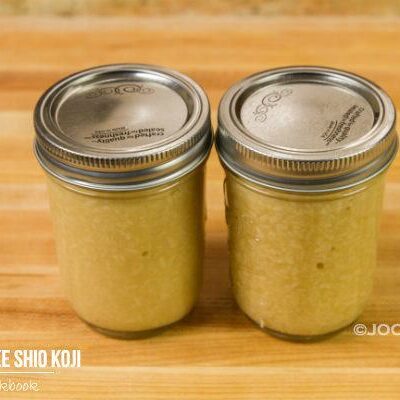
How To Make Shio Koji
Video
Ingredients
- 200 g rice koji (7.05 oz)
- 4–5 Tbsp sea salt (can be 10–30% of koji quantity; do not use table salt)
- 1 cup water
Instructions
- Gather all the ingredients.

- In a large bowl, break 200 g rice koji and separate the koji grains into smaller pieces.

- Rub the koji firmly in your hands to separate into individual grains.

- Rub the koji until aromatic, add 4–5 Tbsp sea salt, and mix all together.

- Add 1 cup water. If necessary, add more water if it doesn‘t cover the surface of the koji. Rub the koji with your hands.

- Transfer to sterilized jar(s)/container with a lid. Make sure the shio koji is submerged in water; if not, add more water.

- Ferment the shio koji at room temperature, open the lid and mix it once a day for 1 week during the summer and 2 weeks during the winter (as warm temperature speeds up the ripening process). Add a bit of water if the shio koji is too hard. It might taste salty at the beginning, but it will gradually become mild. Shio Koji will become thicker and begin to smell sweet from the fermentation.
To Store
- Store in the refrigerator for up to 6 months.
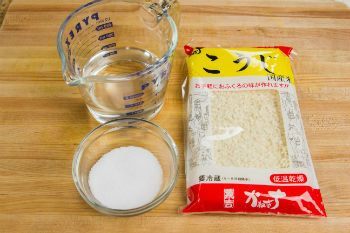

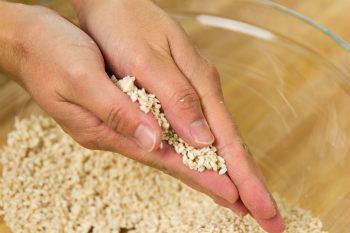


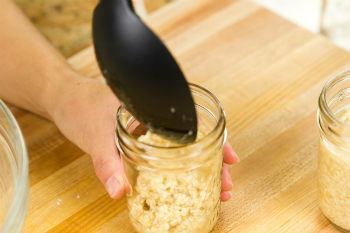










Hello Nami!
I’ve made plain shio koji but also ginger Koji and garlic koji.
They all have different colors and smells but I have no idea to know when they will be ready.
It’s been a week now and started with warm water but really…. How do we know if they are ready to use?
All I know if that my shio koji smells sweet now and has that specific moldy smell? I don’t know how to describe it.
If you could help!
Thank you
Hi, Andrea! Thank you very much for trying Nami’s recipe!
When Koji begins to smell sweeter, more liquified, and watery, it is ready for use. It will continue to ferment, and the taste will improve with time.🙂
We hope this helped!
Hi,
I’ve used your recipe to make Shio Koji and it turned out great! One question I had is that dark/ black-brown liquid has started forming at the top of the shio koji (I’ve kept it in the fridge). What should I do the liquid? Do I mix it in or pour it out? Is it still safe to consume?
Thank you!
Hi Elle, Thank you for trying Nami’s recipe.
It’s difficult to tell without seeing the image. However, if there is no black dot and only brownish liquid, everything should be fine.
It is similar to Miso and is caused by the Maillard reaction (browning reaction) caused by amino acid action. If you like, you can remove it.
We hope this was helpful!
Hello, what size are the jars you use for this, please? Thanks for sharing the recipe!
Hi Sas! Thank you for trying Nami’s recipe!
Nami used two 8 oz jars for this recipe.
We hope this helps!
[…] Eats tutorial recommends a 5:4:1 ratio of water to koji to salt (either kosher or sea). Meanwhile, Just One Cookbook (THE Japanese cooking bible, FYI) recipe is more flexible, suggesting that salt can be 10-30% […]
Hi, would you use amazake as an ingredient in fish marinades? You have great recipes.
Hi Lucy! Thank you for reading Nami’s post!
The one marinades with Sake Lees is called “Kasuzuke,” and currently, Nami has few recipes.
We hope you enjoy it!
https://www.justonecookbook.com/salmon-kasuzuke/
https://www.justonecookbook.com/tsukemono-kasuzuke-sake-lees-pickling/
Hi! Thank you for the lovely site! Can I use an electronic fermenter (like those for making black garlic/kimchi/natto/yogurt) to make this recipe?
Hi Lito! Thank you very much for your kind feedback!
Yes! You can use an electronic fermenter for this recipe. Enjoy!
Hi Nami,
I recently purchased some shio koji and would like to experiment with it. Would you please suggest some of your recipes that use it?
Thank you and Happy New Year,
Lisa
Hi Lisa! Happy New Year! Thank you very much for trying Nami’s recipes. We have many recipes using Shio Koji: https://www.justonecookbook.com/search/?q=shiokoji You can also search recipes by entering “Shio koji” in the search box at the top right corner. We hope this helps! Enjoy!
What kind of Koji rice are you using. There are several varieties available on Amazon. Could you put a link in so one gets the right variety? Thank you.
Hi J’Marinde, Thank you very much for trying this recipe! Here is the link for Koji rice: https://amzn.to/2NjZJdq We hope this helps!
Hi! thank you for the recipe. After two weeks you used to switch to blender shio koji? Or use it as it is? Thank you!
Hi Sandra, You do not need to use a blender. But some people use a blender to make it into a paste too. Most people use it as is. We hope this helps.🙂
Thank you 🙂
Hi Sandra, You are welcome!🤗